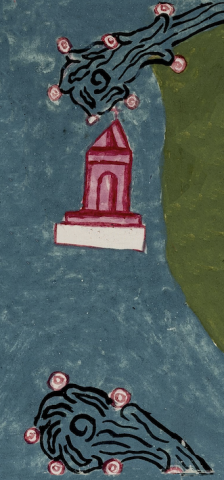Atlitic (YacRG)
This is a compound glyph naming Atlitic (which could be spelled Atl Itic), an estancia (subject community) of the cabecera (head town) known today as Yecapixtla (Morelos). The glyph appears on the map of the Relación Geográfica de Acapistla (another rendition of the same place name, which probably should be Yacapitztla) dating from 1581. The glyph is rather dispersed on the map, so that is how it appears here, too. Perhaps it is not quite a glyph, but glyph-like. The place name means “amidst the waters,” which is why the painting of the community’s church (a semantic indicator for “place”) is shown between the two water features, atl, water, and itic, amidst, between, or inside. The two water features are outlined in black and have several nodes tipped with small concentric red-outlined circles representing droplets, precious gems, or both (but nothing that seems to be a turbinate shell). The water features are shown as swirling, roughly circular elements on the end of streams. These features have blue water, wavy black lines, and black spiral vortexes in their centers. The small church, in frontal view, is outlined in red and colored in red and pink, has a large arched doorway, and a double peaked roof surmounted by a cross. The structure has a horizontal, rectangular base, which sits on top of a red-outlined but otherwise uncolored rectangular box holding the alphabetic gloss (see the historical contextualizing image and gloss).
Robert Haskett
Atl Itic is described briefly in the Relación’s Spanish-language text. This text explains that the place name refers to the location of the town “in the middle of two fountains (fuentes),” which should probably be translated as “springs.” Nahuatl speakers may have referred to them as ameyalli (“natural springs”), though that word does not appear in the text or on the map. The compound glyph for Atl Itic not only appears between the two water features, but also two other estancias and their churches, Xochitlan on its right, and Texcala on its left (see the historical contextualizing image). For more information about this RG see Mundy (1996).
Robert Haskett
Atlitiqui estançia
Atlitic estancia
Robert Haskett
1581
Robert Haskett
The drawing of the church between the two water features is an element that signals the "amidst" part of the place name.
springs, fuentes, ojos de agua, nombres de lugares
This important Indigenous community, part of the Cortés Marquesado del Valle jurisdiction and one of the so-called Quatro Villas, was glossed in various ways over time (Acapixtla, Acapiztla, Yecapiztlan, Yacapixtlan, Yacapichtlan, Ayacapitztlan, etc.). The modern spelling is Yecapixtla.

atlitic, inside the water, https://nahuatl.wired-humanities.org/content/atlitic
a(tl), water, https://nahuatl.wired-humanities.org/content/atl
itic, inside, in the midst of, https://nahuatl.wired-humanities.org/content/itic
ameyal(li), natural spring, fountain, https://nahuatl.wired-humanities.org/content/ameyalli
Entre las Fuentes, Entre los Ojos de Agua
Robert Haskett
Relación de Acapistla – University of Texas Libraries Collections, 1580-11-15. https://collections.lib.utexas.edu/catalog/utblac:740d6d5b-280a-45f4-a3b...
Materials that are in the public domain (such as most of the maps in the PCL Map Collection) are not copyrighted, and no permission is needed to copy them. You may download them and use them as you wish. The image appears here courtesy of the University of Texas Libraries, The University of Texas at Austin. If you do publish anything from this database, please cite the Visual Lexicon of Aztec Hieroglyphs.







